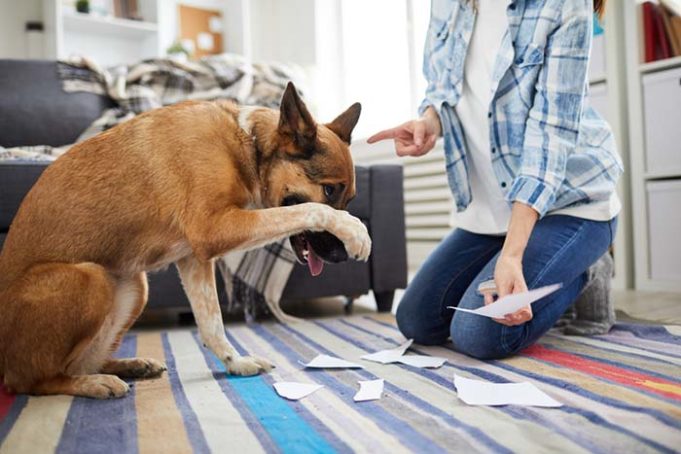Some owners admit MYSELF INCLUDED that we've jumped at the opportunity of adopting a dog without doing much research into what taking care of an animal means or requires.
Dogs have needs that must be met, health conditions that arise, maintenance, and medications to keep them healthy, and there's time, money and patience required to integrate them into a new home.
So I will break down a quick list of five things I wish I knew and should've known (Google and YouTube is a thing, amiright?) before adopting a dog.
1. Housetraining is a full-time effort
I thought when I got my puppy Belle, she'd know better than to not pee and poop in the house.
Let alone, I thought she could hold it longer, yeesh!
Your dog (puppy or not) does not naturally pick up on where to pee and where not to pee or how to give owners a signal to remind them that they need to be taken outside.
This leads to many potty-training incidents in the house between peeing and pooping before and after walks.
When accidents happened, it was my fault for not understanding what my dog needed.
The solution is to be more proactive than me.
Make sure that you're taking the dog outside frequently enough that they have the chance to release their bladder and reduce the risk of them going into the house.
Once they begin using the bathroom in the house, it becomes a hard habit to break.
For example, when I come home from the gym early in the morning around 6:45/7am I would come home and put her leash on and take her out.
Sure enough, she'd immediately go potty. Now you can be a little more lenient on time with older dogs, like shower and feed them first possibly.
Check for signs of sniffing and walking around instead of relaxing; it may be a sign that your dog needs to use the bathroom.
Adopt a regular and consistent walk schedule with times you can easily maintain.
One thing I'd like to add too, make sure you take your dog out and try to get them to go to the bathroom one last time before bed.
If you don't and your dog is in a crate, you may wake up to a pee-filled crate or some nice poopies.
If your dog isn't crated, you'll find the present either right away or later if your dog gets sneaky with where they like to hide their accidents.
Most importantly, stay on a routine, don't adjust it until you're confident your dog can hold it longer.
2. The need to dog-proof your home
Like children, dogs know exactly what they are not supposed to chew on or mess with, which is what they go for first.
Be prepared to have shoes, towels, socks, underwear, and anything else within reach to get torn up.
Anything that your dog can touch, they will grab and take off with, especially if it is a puppy or a young stray.
I stopped crating my dog early on because I felt bad to leave her in there, and have come home to many chewed shoes, socks, and shirts.
Take it from me, pet-proof your home.
Get on their height level and look around for anything that could be within reach.
Keep all fragile items on the upper shelves and hide all the potentially dangerous items.
The next step is making sure that everyone within the home is on the same page regarding the dog's restrictions.
You and your living mate, significant other, or spouse must understand and agree to abide by the limitations of where the dog is allowed and where they are not.
When there is no agreement on where they should be, it makes housebreaking training confusing and longer.
3. Are You Prepared For The Cost?
Dogs cost more than just the initial adoption fee.
Depending on where your dog is from, it may need to be neutered or spayed or have an underlying health condition that will run up the vet bills.
Your dog also needs food, toys, microchipping, flea and tick medication, and possibly training classes if it is too much to do on your own.
Fortunately, the microchipping is usually done prior to adoption.
There are many lifelong care expenses that some owners forget to consider, too.
In addition to the best care and upkeep cost of having a dog, there are extra fees.
Leashes, collars, and other dog equipment can cost a lot and depend on the environment where you live, and you may need to invest in a heated doghouse or coats.
If the dog will be kennel trained, be prepared to purchase multiple sizes over time.
Dogs grow, and if the dog is less than a year old, expect them to continue growing.
The same goes for collars; dogs grow and will possibly need different size collars as they continue to grow.
4. Dogs to socialize regularly
First-time dog owners may not realize how social dogs are and how social they need to be in order to keep up with their physical and mental health.
Socialization with only the owner may not be enough for younger dogs with lots of energy, especially if they are not able to go outside and frequently run during the day.
Dogs are social creatures and will not likely leave you alone.
Be prepared to be followed to the bathroom, bedroom, den, and anywhere else in the home you plan to go to.
If you like to travel a lot, you'll need to bring the dog with you.
If you're not able to meet the social demands of the dog on your own, you can plan playdates with other dogs and dog owners in the area or take them to a dog park where they can socialize with multiple different dogs.
This does not need to be every day as long as you are showing them attention, but it needs to happen a minimum of twice a month and preferably once a week.
5. Nutrition and safety of pet foods
Some owners will only feed their dog the pet food they pick from the store.
While most dogs will eat anything, there are good and bad dog foods that offer (or don't offer) different health benefits and provide different nutrients.
The quality of the food is not determined by the price; that is why research is necessary to find the right dog food for your dog.
Like with regular human food, there are dog junk foods and healthy dog foods.
Dogs can live off of junk food, but to keep them in the best health they require healthy food. Some dogs are also more sensitive to specific ingredients and require extra nutrients.
This will depend on breed, age, and personal allergies.
Keep in mind that most dogs do not require grain-free or gluten-free foods.
Adopting a Dog
Don't be surprised when the pooch does not adapt to the new environment immediately, and it takes time for them to adjust and get comfortable.
Make the change somewhat easier by guiding them in the right direction by making sure they are adequately trained and treated.
Dogs are loyal creatures and will learn to trust you after some time has passed.
 Sometimes the amount of effort it takes to raise a dog is underestimated, and owners are not prepared to provide that amount of care and time.
Sometimes the amount of effort it takes to raise a dog is underestimated, and owners are not prepared to provide that amount of care and time.
Work the price of pet care into the monthly budget beforehand and keep track of any spare time in your day-to-day life that could be committed to caring for the new dog.
Make sure to research what caring for a dog requires before becoming an owner.
Giving a dog a new and loving home is always great, but if the home is not ready or the owner is not ready, it can cause more confusion and discomfort for the dog and for you.













